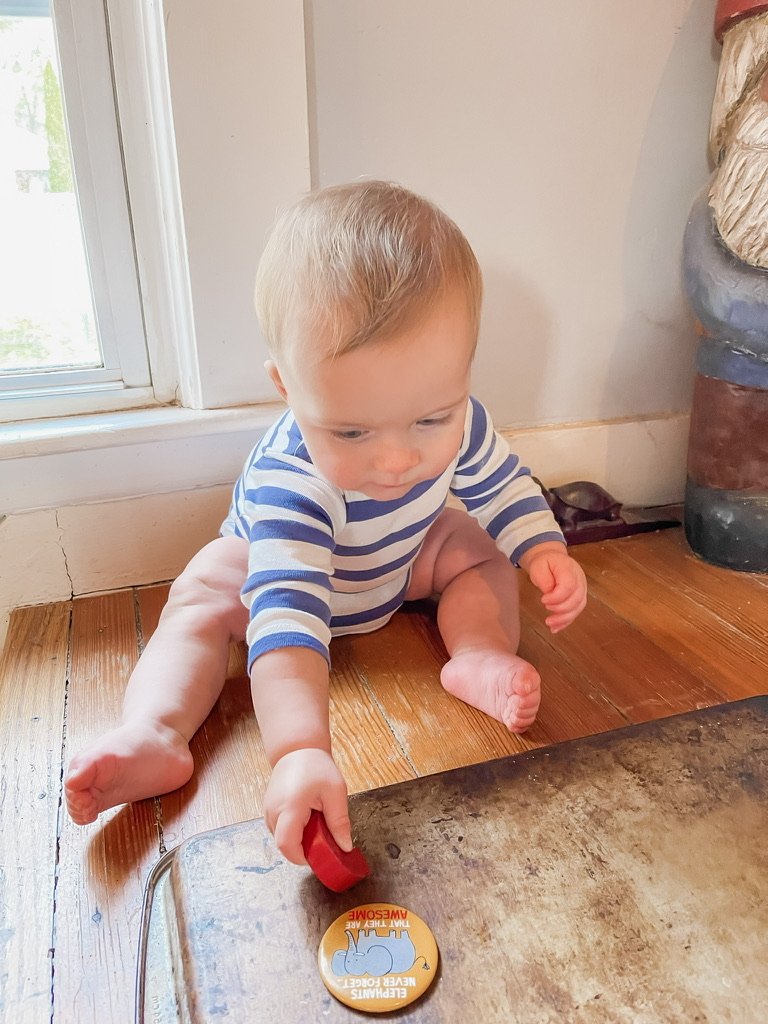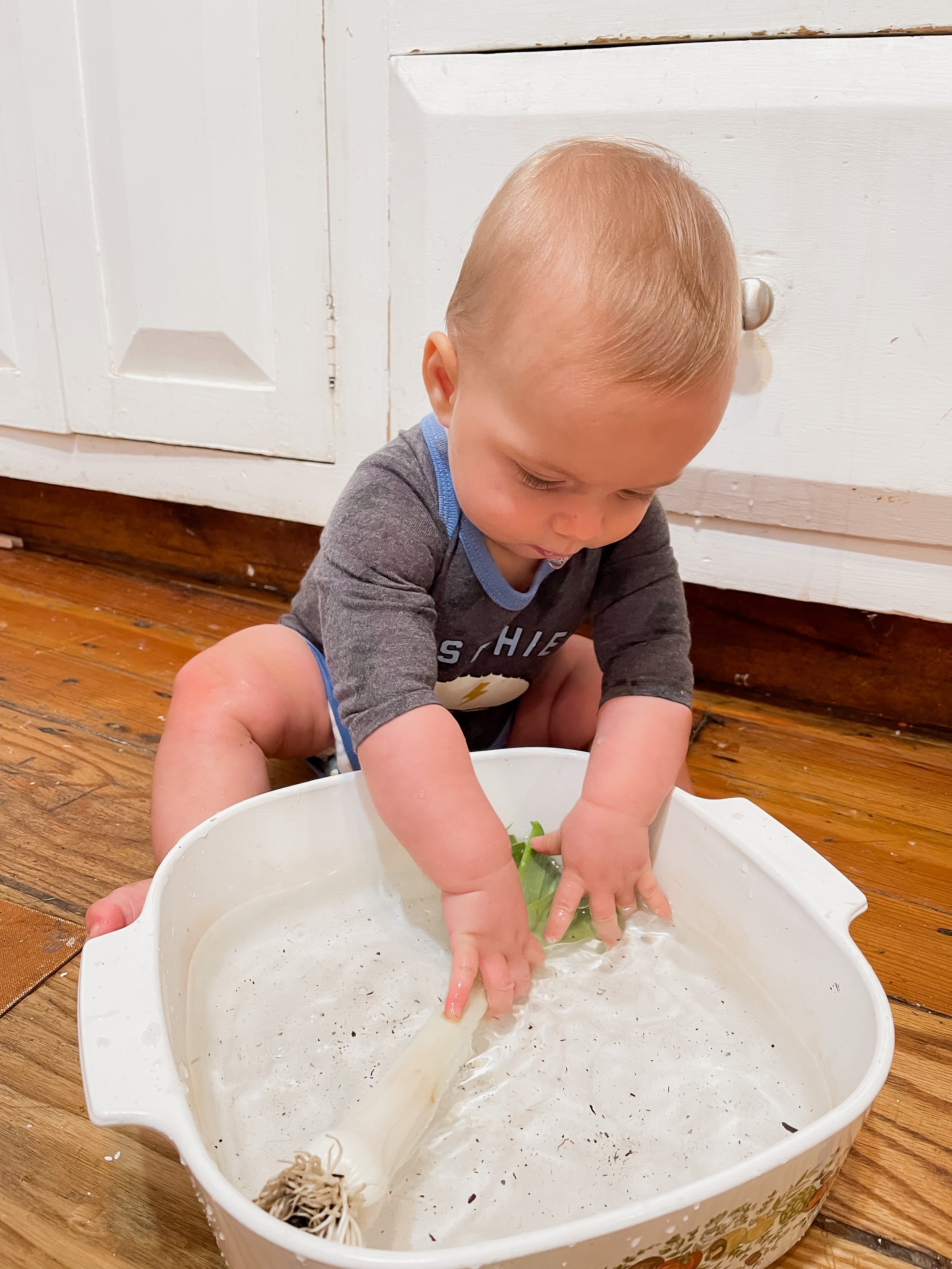Favorite Activities 6-12 Months
This post may contain affiliate links, which means I may earn a small commission if you buy through my link but does not change your price.
I get a lot of requests for baby activities. We do not do activities every day but occasionally I enjoy throwing together quick activities. I never do activities that take a long time to prepare. I actually didn’t realize how many activities we had done in the last several months until I compiled them all here. A few are possible for younger babies from around 3 months, but in general, most of these are for 6 months plus. Some of these activities are a bit advanced for the younger end of that age group and are more appropriate for 9 months plus. Always follow your own child and their interests. It is normal if your baby is not interested in all of these activities. Not all of them were total hits with Yitzchak either.
Fine Motor
Magnet Pull: Place large magnets on a baking sheet and let them pull them off. For a sitting baby you can also place them on a fridge and for a baby pulling up you can place further up a fridge to allow them to pull while standing.
Tape Pull: Tape down teethers or other toys and let them pull the tape off. Blue painter’s tape works best.
O Cereal in a Muffin Pan: work on pincer grasp by placing O cereal in each of the holes of the muffin pan.
Rubberband Escape: Place mouthing safe toys in a baking tin such as a loaf pan. Put rubberbands all around it. Make sure all the rubberbands are very secure (you could also tape on the bottom). Note that rubberbands are a choking hazard and as with anything with small parts, monitor closely.
Balls in a muffin tin: Put balls in the holes of the muffin tin. For more of a challenge place blue painter’s tape covering the holes and let your baby first pull that off.
Whisk Escape: Stuff the whisk with a play scarf (I have also seen it done with socks) and let your baby pull out the scarf.
Paper tearing: Give tissue paper or wrapping paper. Model tearing strips and placing in a basket. They likely will not place the ripped paper in the basket but that is okay. At the end model putting it in the recycling.
Pots and Pans Drumming: Give your little one a wooden spoon and some pots and pans and allow them to drum on them.
Sensory
Vegetable Washing: Let your little one join you in the kitchen. Prepare a large container of water such as a roasting pan or even a sheet pan. Place the vegetables in and let them “wash” them.
Water Play: This is so simple but still fun. Just give a tub of water and let them explore.
Mess-Free Painting: Place a paper with paint placed on it in a ziplock bag. Securely close the bag and tape it to the ground. Allow your little one to mix the paints around to paint a picture.
Taste-Safe Painting: Add some food coloring to yogurt and allow your little one to paint with it. This one is great in the bathtub. Beets, turmeric, etc. can also be used for natural food coloring.
Jello Dig: Place some teethers or other waterproof toys in a pan and pour Jello over it. Let it harden. I recommend a non-flavored Jello to discourage eating something sweet. You can also use food coloring but that increases the mess.
Chickpea Foam: Beat chickpea water with 1/4 teaspoon cream of tarter for several minutes until stiff peaks appear. Place it in a baking sheet for your baby to explore. You can place toys in it as well.
Cornstarch and Water: Mix one cup water with one and a half cups cornstarch. Add a couple drops of food coloring if you would like it to be colored.
Snow: Place snow into a baking sheet. You can add a few drops of food coloring if you would like.
Rainbow Spaghetti: Take large ziplock freezer bags and put about 20 drops of food coloring in each one along with two tablespoons water, one color to one bag. Prepare a large batch of spaghetti as you normally would. Drain the spaghetti and rinse under cold water to stop the cooking. Divide the spaghetti into the different bags. Mix it around and let sit for at least a minute.
Gross Motor
Baby Obstacle Course: Create piles with pillows and tunnels with boxes to challenge a more experienced crawler.
Pillow Mountain: Create a mountain of pillows and place a toy on top for them to rescue. This is also better for a more experienced crawler.
Free Bathing: We did this from around 4 months but placing a small amount of water in the tub and allowing your baby to lie down and splash is really fun for bathtime even before they are able to sit up.
Cognitive
Treasure Basket: This activity can be done from around 3 months, but it is still fun at 6-12 months. Take a basket and put some objects in and let them explore. You can do them based on a theme such as a holiday. We did a Rosh Hashanah one with an apple, a stuffed bee, a prayer book, and a shofar. Or you can use all kitchen items or all balls. When possible try to engage different senses (something to smell, for example) and give a variety of materials and textures. For example with kitchen items you could use a metal whisk and a fabric pot holder. The cold metal of the whisk feels very different than the fabric. In Montessori it is generally recommended to try to use natural materials.
Ball Under Cup Search: As object permanence develops (around 8-9 months) take two cups. Sit with your baby in front of you. Place a ball under one of the cups and let them find the ball.
Toy Hide and Seek: in your baby’s view place a stuffed animal or another toy under a blanket. Let your baby find it. Start with having the toy partly out of the blanket then fully under. After they have mastered that hide the toy when they are not looking.
Peekaboo: This classic activity also helps your baby develop object permanence and understand that you continue to exist even when you are out of sight. It can also be a useful activity when your little one is experiencing separation anxiety. We love using our play scarves.
Cabinet Hide and Seek: Hide toys in a cabinet (either when they see you do it or out of their view) and let them explore the cabinets.
Searching for Objects in Containers: Hide some toys in containers that your baby is able to open and let them explore finding them.























